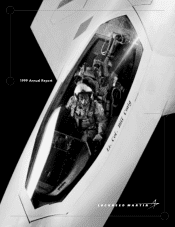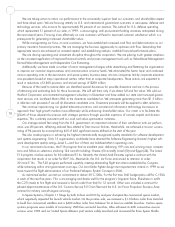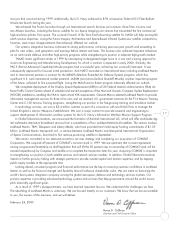Lockheed Martin 1999 Annual Report Download - page 11
Download and view the complete annual report
Please find page 11 of the 1999 Lockheed Martin annual report below. You can navigate through the pages in the report by either clicking on the pages listed below, or by using the keyword search tool below to find specific information within the annual report.
missions that occurred during 1999. Additionally, the U.S. Navy achieved its 87th consecutive Trident II D-5 Fleet Ballistic
Missile test launch during the year.
We achieved five Proton launches through our International Launch Services joint venture, three Titan missions and
two Athena launches, including the Ikonos satellite for our Space Imaging joint venture that transmitted the first commercial
high-resolution photos from space. The successful launch of the Terra Earth-observing satellite for NASA will help accomplish
earth science objectives. Losing the Future Imagery Architecture and Space-Based Infrared System-Low satellite competitions,
however, were major disappointments that adversely affected our outlook.
Our systems integration business continued its strong performance, achieving year-over-year growth and exceeding its
plan for new orders, cash generation and earnings before interest and taxes. The business also achieved important milestones
on air and missile defense and other high-priority programs while strengthening its position in adjacent high-growth markets.
THAAD made significant strides in 1999 by intercepting its designated target twice in a row and winning approval to
move into Engineering and Manufacturing Development, for which a contract is expected in early 2000. Similarly, the
PAC-3 (Patriot Advanced Capability) Missile program had a successful year, achieving two successful intercepts. It was
subsequently approved for low-rate initial production. And NATO awarded an international team including Lockheed Martin
and its international partners a contract for the MEADS (Medium Extended Air Defense System) program, which has
significant U.S. and international market potential. JASSM ( Joint Air-to-Surface Standoff Missile), another important program
of the future, achieved its first powered flight. Losing the Multi-Function Radar program adversely affected our outlook.
We completed deployment of the Display System Replacement (DSR) to all 20 Federal Aviation Administration (FAA) Air
Route Traffic Control Centers ahead of schedule and earned acceptance of the Host and Oceanic Computer System Replacement
(HOCSR) installations, enabling the FAA to meet critical Y2K requirements. General Motors selected Lockheed Martin to provide
information management services for three of its units, and we received U.S. government contracts for the F-16 Mission Training
Center and C-130 Aircrew Training programs, strengthening our position in the fast-growing training and simulation market.
In technology services, we won a $3.4 billion contract as part of a consortium with two British firms to manage the
United Kingdom’s Atomic Weapons Establishment. We won a major contract to provide research and engineering to
support development of information warfare systems for the U.S. Navy’s Information Warfare Mission Support Program.
In Global Telecommunications, we announced the formation of Astrolink International LLC, which will offer worldwide dig-
ital multimedia interactive broadband services from a constellation of four Lockheed Martin-built satellites. The venture involves
Lockheed Martin, TRW, Telespazio and Liberty Media, who have provided total initial equity funding commitments of $1.35
billion. Lockheed Martin Intersputnik, Ltd., a venture between Lockheed Martin and Intersputnik International Organization
of Space Communications, launched its first revenue-producing satellite in September.
We remain committed to our telecommunications services strategy and completing our acquisition of COMSAT
Corporation. We acquired 49 percent of COMSAT’s common stock in 1999. We are optimistic that a recent agreement
among congressional leadership on draft legislation that will lift the 50 percent cap on ownership of COMSAT stock will be
enacted expeditiously by Congress and enable us to complete the transaction later this year. Acquiring COMSAT is important
to strengthening our position in both satellite services and network services markets. In addition, Global Telecommunications
intends to further grow by linking with strategic partners to provide outside capital and domain expertise, and by tapping
public equity markets at the appropriate time.
Looking ahead, consistent program and financial performance are the keys to restoring customer confidence in Lockheed
Martin as well as the financial strength and flexibility that will enhance shareholder value. We are intent on becoming the
world’s best systems integration company serving the global aerospace, defense and technology services markets. Our
primary expertise is providing advanced technology systems and services that help governments around the world accom-
plish nationally significant goals.
As a result of 1999’s disappointments, we have learned important lessons. We understand the challenges we face.
The rebuilding of Lockheed Martin is underway. We are focused intently on our customers. We know that we are accountable
to you, the owners of this business, and we will deliver.
February 24, 2000
Vance D. Coffman
Chairman and Chief Executive Officer
17
























